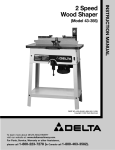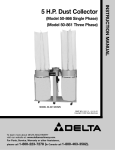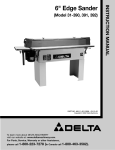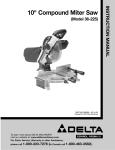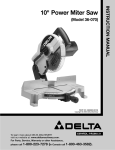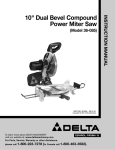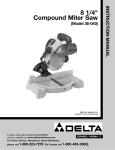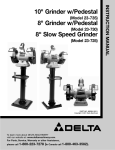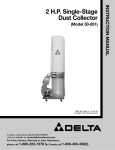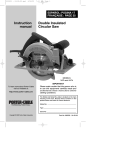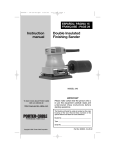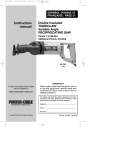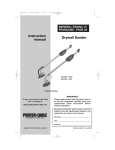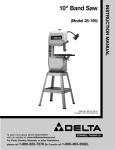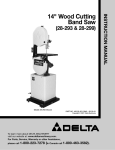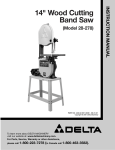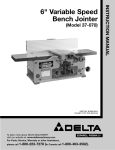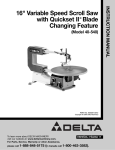Download Delta 31-280 Instruction manual
Transcript
PART NO. 406-12-651-0004 - 07-31-01) Copyright © 2001 Delta Machinery To learn more about DELTA MACHINERY visit our website at: www.deltamachinery.com. For Parts, Service, Warranty or other Assistance, please call 1-800-223-7278 (In Canada call 1-800-463-3582). INSTRUCTION MANUAL Sanding Center 6" Belt/12" Disc Sander (Model 31-280) GENERAL SAFETY RULES Woodworking can be dangerous if safe and proper operating procedures are not followed. As with all machinery, there are certain hazards involved with the operation of the product. Using the machine with respect and caution will considerably lessen the possibility of personal injury. However, if normal safety precautions are overlooked or ignored, personal injury to the operator may result. Safety equipment such as guards, push sticks, hold-downs, featherboards, goggles, dust masks and hearing protection can reduce your potential for injury. But even the best guard won’t make up for poor judgment, carelessness or inattention. Always use common sense and exercise caution in the workshop. If a procedure feels dangerous, don’t try it. Figure out an alternative procedure that feels safer. REMEMBER: Your personal safety is your responsibility. This machine was designed for certain applications only. Delta Machinery strongly recommends that this machine not be modified and/or used for any application other than that for which it was designed. If you have any questions relative to a particular application, DO NOT use the machine until you have first contacted Delta to determine if it can or should be performed on the product. Technical Service Manager Delta Machinery 4825 Highway 45 North Jackson, TN 38305 (IN CANADA: 505 SOUTHGATE DRIVE, GUELPH, ONTARIO N1H 6M7) WARNING: FAILURE TO FOLLOW THESE RULES MAY RESULT IN SERIOUS PERSONAL INJURY! 17. REDUCE THE RISK OF UNINTENTIONAL STARTING. Make sure switch is in “OFF” position before plugging in power cord. In the event of a power failure, move switch to the “OFF” position. 18. NEVER STAND ON TOOL. Serious injury could occur if the tool is tipped or if the cutting tool is accidentally contacted. 19. CHECK DAMAGED PARTS. Before further use of the tool, a guard or other part that is damaged should be carefully checked to ensure that it will operate properly and perform its intended function – check for alignment of moving parts, binding of moving parts, breakage of parts, mounting, and any other conditions that may affect its operation. A guard or other part that is damaged should be properly repaired or replaced. 20. DIRECTION OF FEED. Feed work into a blade or cutter against the direction of rotation of the blade or cutter only. 21. NEVER LEAVE TOOL RUNNING UNATTENDED. TURN POWER OFF. Don’t leave tool until it comes to a complete stop. 22. STAY ALERT, WATCH WHAT YOU ARE DOING, AND USE COMMON SENSE WHEN OPERATING A POWER TOOL. DO NOT USE TOOL WHILE TIRED OR UNDER THE INFLUENCE OF DRUGS, ALCOHOL, OR MEDICATION. A moment of inattention while operating power tools may result in serious personal injury. 23. MAKE SURE THE TOOL IS DISCONNECTED FROM THE POWER SUPPLY while the motor is being mounted, connected, or reconnected. 24. THE DUST GENERATED by certain woods and wood products can be injurious to your health. Always operate machinery in well ventilated areas and provide for proper dust removal. Use wood dust collection systems whenever possible. 1. F O R Y O U R O W N S A F E T Y, R E A D I N S T R U C T I O N MANUAL BEFORE OPERATING THE TOOL. Learn the tool’s application and limitations as well as the specific hazards peculiar to it. 2. KEEP GUARDS IN PLACE and in working order. 3. ALWAYS WEAR EYE PROTECTION. Wear safety glasses. Everyday eyeglasses only have impact resistant lenses; they are not safety glasses. Also use face or dust mask if cutting operation is dusty. These safety glasses must conform to ANSI Z87.1 requirements. Note: Approved glasses have Z87 printed or stamped on them. 4. REMOVE ADJUSTING KEYS AND WRENCHES. Form habit of checking to see that keys and adjusting wrenches are removed from tool before turning it “on”. 5. KEEP WORK AREA CLEAN. Cluttered areas and benches invite accidents. 6. DON’T USE IN DANGEROUS ENVIRONMENT. Don’t use power tools in damp or wet locations, or expose them to rain. Keep work area well-lighted. 7. KEEP CHILDREN AND VISITORS AWAY. All children and visitors should be kept a safe distance from work area. 8. MAKE WORKSHOP CHILDPROOF – with padlocks, master switches, or by removing starter keys. 9. DON’T FORCE TOOL. It will do the job better and be safer at the rate for which it was designed. 10. USE RIGHT TOOL. Don’t force tool or attachment to do a job for which it was not designed. 11. WEAR PROPER APPAREL. No loose clothing, gloves, neckties, rings, bracelets, or other jewelry to get caught in moving parts. Nonslip footwear is recommended. Wear protective hair covering to contain long hair. 12. SECURE WORK. Use clamps or a vise to hold work when practical. It’s safer than using your hand and frees both hands to operate tool. 13. DON’T OVERREACH. Keep proper footing and balance at all times. 14. MAINTAIN TOOLS IN TOP CONDITION. Keep tools sharp and clean for best and safest performance. Follow instructions for lubricating and changing accessories. 15. DISCONNECT TOOLS before servicing and when changing accessories such as blades, bits, cutters, etc. 16. USE RECOMMENDED ACCESSORIES. The use of accessories and attachments not recommended by Delta may cause hazards or risk of injury to persons. 25. WARNING: SOME DUST CREATED BY POWER SANDING, SAWING, GRINDING, DRILLING, AND OTHER CONSTRUCTION ACTIVITIES contains chemicals known to cause cancer, birth defects or other reproductive harm. Some examples of these chemicals are: · lead from lead-based paints, · crystalline silica from bricks and cement and other masonry products, and · arsenic and chromium from chemically-treated lumber. Your risk from these exposures varies, depending on how often you do this type of work. To reduce your exposure to these chemicals: work in a well ventilated area, and work with approved safety equipment, such as those dust masks that are specially designed to filter out microscopic particles. SAVE THESE INSTRUCTIONS. Refer to them often and use them to instruct others 2 ADDITIONAL SAFETY RULES FOR SANDING CENTER 1. 2. WARNING: Do not operate this tool until assembly and installation are complete, according to instructions. WARNING: Unguarded rotating shafts can create an entanglement hazard. ALWAYS COVER THE POWER TAKEOFF SHAFT when accessories are not in use. 3. IF YOU ARE NOT thoroughly familiar with the operation of Belt and Disc Sanders, obtain advice from your supervisor, instructor, and/or other qualified persons. 4. CAUTION: This tool is designed to sand wood or wood-like products only. Sanding or grinding metal could result in fire, injury, or damage to the product. 5 REMOVE SCRAP PIECES, TOOLS, and other objects from the table before turning the machine “ON.” 6. NEVER START THE TOOL while the work piece is contacting the sanding belt or disc. 7. CHECK TO SEE that the sanding belt runs in the proper direction. A directional arrow is printed on the back side of belt. 8. CHECK THE BELT to see that it is tracking correctly. 9. CHECK THE BELT AND DISC to see that they are not torn or loose. 10. HOLD the work firmly while sanding. 11. MAINTAIN a maximum clearance of 1/16" between the table and the sanding belt or disc. 12. KEEP hands away from abrasive surfaces. 13. USE A BACKSTOP while sanding with the sanding arm in the horizontal position. 14 NEVER wear gloves or hold the work with a rag while sanding. 15. ALWAYS sand on the downward rotation of the disc and hold the work securely on the table. Sanding on the upward rotation could cause the work piece to be thrown upward. 16. SAND with the grain of the wood. 17. DO NOT sand small workpieces that cannot be safely supported. 18. AVOID awkward hand positions where a sudden slip could cause hand contact with the abrasive surfaces. 19. PROVIDE ADDITIONAL SUPPORT at table height while sanding large work pieces. 20. NEVER perform layout, assembly, or set-up work on the tables while the tool is “ON”. 21. IMPORTANT: When the tool is not in use, the switch should be locked in the “OFF” position to prevent unauthorized use. 22 ADDITIONAL INFORMATION regarding the safe and proper operation of this product is available from the National Safety Council, 1121 Spring Lake Drive, Itasca, IL 60143-3201 in the Accident Prevention Manual for Industrial Operations and also in the Safety Data Sheets provided by the NSC. Please also refer to the American National Standards Institute ANSI 01.1 Safety Requirements for Woodworking Machinery and the U.S. Department of Labor OSHA 1910.213 Regulations. POWER CONNECTIONS A separate electrical circuit should be used for your tools. This circuit should not be less than #12 wire and should be protected with a 20 Amp time lag fuse. If an extension cord is used, use only 3-wire extension cords which have 3-prong grounding type plugs and matching receptacle which will accept the tool’s plug. Before connecting the motor to the power line, make sure the switch is in the “OFF” position and be sure that the electric current is of the same characteristics as indicated on the tool. All line connections should make good contact. Running on low voltage will damage the motor. WARNING: DO NOT EXPOSE THE TOOL TO RAIN OR OPERATE THE TOOL IN DAMP LOCATIONS. MOTOR SPECIFICATIONS Your tool is wired for 120 volt, 60 HZ alternating current. Before connecting the tool to the power source, make sure the switch is in the “OFF” position. 3 GROUNDING INSTRUCTIONS WARNING: THIS TOOL MUST BE GROUNDED WHILE IN USE TO PROTECT THE OPERATOR FROM ELECTRIC SHOCK. A temporary adapter, which looks like the adapter illustrated in Fig. 2, may be used to connect this plug to a matching 2conductor receptacle as shown in Fig. 2 if a properly grounded outlet is not available. The temporary adapter should be used only until a properly grounded outlet can be installed by a qualified electrician. The green-colored rigid ear, lug, and the like, extending from the adapter must be connected to a permanent ground such as a properly grounded outlet box. Whenever the adapter is used, it must be held in place with a metal screw. NOTE: In Canada, the use of a temporary adapter is not permitted by the Canadian Electric Code. 1. All grounded, cord-connected tools: In the event of a malfunction or breakdown, grounding provides a path of least resistance for electric current to reduce the risk of electric shock. This tool is equipped with an electric cord having an equipment-grounding conductor and a grounding plug. The plug must be plugged into a matching outlet that is properly installed and grounded in accordance with all local codes and ordinances. Do not modify the plug provided - if it will not fit the outlet, have the proper outlet installed by a qualified electrician. Improper connection of the equipment-grounding conductor can result in risk of electric shock. The conductor with insulation having an outer surface that is green with or without yellow stripes is the equipment-grounding conductor. If repair or replacement of the electric cord or plug is necessary, do not connect the equipment-grounding conductor to a live terminal. Check with a qualified electrician or service personnel if the grounding instructions are not completely understood, or if in doubt as to whether the tool is properly grounded. Use only 3-wire extension cords that have 3-prong grounding type plugs and matching 3-conductor receptacles that accept the tool’s plug, as shown in Fig. 1. Repair or replace damaged or worn cord immediately. 3. Grounded, cord-connected tools intended for use on a supply circuit having a nominal rating between 150 250 volts, inclusive: If the tool is intended for use on a circuit that has an outlet that looks like the one illustrated in Fig. 3, the tool will have a grounding plug that looks like the plug illustrated in Fig. 3. Make sure the tool is connected to an outlet having the same configuration as the plug. No adapter is available or should be used with this tool. If the tool must be reconnected for use on a different type of electric circuit, the reconnection should be made by qualified service personnel; and after reconnection, the tool should comply with all local codes and ordinances. 2. Grounded, cord-connected tools intended for use on a supply circuit having a nominal rating less than 150 volts: If the tool is intended for use on a circuit that has an outlet that looks like the one illustrated in Fig. 1, the tool will have a grounding plug that looks like the plug illustrated in Fig. 1. WARNING: IN ALL CASES, MAKE CERTAIN THAT THE RECEPTACLE IN QUESTION IS PROPERLY GROUNDED. IF YOU ARE NOT SURE, HAVE A QUALIFIED ELECTRICIAN CHECK THE RECEPTACLE. GROUNDED OUTLET BOX GROUNDED OUTLET BOX GROUNDING MEANS CURRENT CARRYING PRONGS ADAPTER GROUNDING BLADE IS LONGEST OF THE 3 BLADES Fig. 1 Fig. 2 GROUNDED OUTLET BOX CURRENT CARRYING PRONGS GROUNDING BLADE IS LONGEST OF THE 3 BLADES Fig. 3 4 EXTENSION CORDS Use proper extension cords. Make sure your extension cord is in good condition and is a 3-wire extension cord which has a 3-prong grounding type plug and matching receptacle which will accept the tool’s plug. When using an extension cord, be sure to use one heavy enough to carry the current of the tool. An undersized cord will cause a drop in line voltage, resulting in loss of power and overheating. Figs. 4A and 4B show the correct gauge to use depending on the cord length. If in doubt, use the next heavier gauge. The smaller the gauge number, the heavier the cord. MINIMUM GAUGE EXTENSION CORD MINIMUM GAUGE EXTENSION CORD RECOMMENDED SIZES FOR USE WITH STATIONARY ELECTRIC TOOLS RECOMMENDED SIZES FOR USE WITH STATIONARY ELECTRIC TOOLS Ampere Rating Volts Total Length of Cord in Feet Gauge of Extension Cord Ampere Rating Volts Total Length of Cord in Feet Gauge of Extension Cord 0-6 0-6 0-6 0-6 120 120 120 120 up to 25 25-50 50-100 100-150 18 AWG 16 AWG 16 AWG 14 AWG 0-6 0-6 0-6 0-6 240 240 240 240 up to 50 50-100 100-200 200-300 18 AWG 16 AWG 16 AWG 14 AWG 6-10 6-10 6-10 6-10 120 120 120 120 up to 25 25-50 50-100 100-150 18 AWG 16 AWG 14 AWG 12 AWG 6-10 6-10 6-10 6-10 240 240 240 240 up to 50 50-100 100-200 200-300 18 AWG 16 AWG 14 AWG 12 AWG 10-12 10-12 10-12 10-12 120 120 120 120 up to 25 25-50 50-100 100-150 16 AWG 16 AWG 14 AWG 12 AWG 10-12 10-12 10-12 10-12 240 240 240 240 up to 50 50-100 100-200 200-300 16 AWG 16 AWG 14 AWG 12 AWG 12-16 12-16 12-16 120 120 120 up to 25 25-50 14 AWG 12 AWG 12-16 12-16 12-16 240 240 240 up to 50 50-100 14 AWG 12 AWG GREATER THAN 50 FEET NOT RECOMMENDED GREATER THAN 100 FEET NOT RECOMMENDED Fig. 4B Fig. 4A CHANGING VOLTAGE The motor supplied with this tool is a dual voltage, 120/240 Volt, Single Phase motor and is wired for 120 volts. To operate the tool at 240 volts: 1. A DISCONNECT TOOL FROM POWER SOURCE. 2. Remove the motor cover (A) Fig. 5 by loosening the six screws that fasten it to the stand. 3. Remove the brown wire from terminal 2. Connect it to terminal 6 (Fig. 6). Fig. 5 4. Remove the blue wire from terminal 4. Connect it to terminal 2 (Fig. 6). NOTE: The wires have spade-type quick connectors. No wire nuts are required. 5. BROWN RED BLUE 2 RED BROWN 6 Replace the motor cover removed in STEP 2. BLUE 6. Replace the 120 volt plug (supplied with the motor) with a 240 volt plug that has two flat, current-carrying prongs, and one round or “U” shaped ground prong. (See Fig. 3) Use this plug ONLY with the proper mating 3-conductor grounded receptacle (See Fig. 3). 6 4 4 1 1 240 VOLTS 120 VOLTS Fig. 6 5 2 OPERATING INSTRUCTIONS FOREWORD Delta Model 31-280 is a powerful 1-1/2 HP belt/disc sander. The induction-type, ball-bearing motor provides long-lasting, smooth performance. The Sanding Center can provide 1971 SFM with the belt, and the disc will revolve at 2500 RPM. UNPACKING AND CLEANING Carefully unpack the tool and all loose items from the shipping container(s). Remove the protective coating from all unpainted surfaces. This coating may be removed with a soft cloth moistened with kerosene (do not use acetone, gasoline or lacquer thinner). After cleaning, cover the unpainted surfaces with a good quality household floor paste wax. CARTON CONTENTS 1 10 16 9 8 7 5 12 13 11 14 3 15 4 6 2 1. 2. 3. 4. 5. 6. 7. Belt/Disc Machine with Top Shelf of Stand 8. 9. 10. 11. 12. 13. Dust 14. Disc Sander Table Dust Chute Sanding Disc Lower Braces for Stand (19.695" long) (2) Lower Braces for Stand (22.080" long) (2) Legs for Stand (4) 1/8" Allen wrench 1/4" Allen wrench 3/16" Allen wrench Stop Block-Circle Sanding Attachment Guide Pin for Circle Sanding Attachment 5/8" Thread Cutting Screws for Mounting Chute (4) 1" Hex Socket Screw for Mounting Disc Sander Table (4) 15. Hardware Package includes 5/8" Carriage Bolts, washers, and nuts for stand (16) 16 Plastic Feet for stand (4) ASSEMBLY INSTRUCTIONS WARNING: FOR YOUR OWN SAFETY, DO NOT CONNECT THE MACHINE TO THE POWER SOURCE UNTIL THE MACHINE IS COMPLETELY ASSEMBLED, AND YOU READ AND UNDERSTAND THE ENTIRE OWNER'S MANUAL. ASSEMBLING STAND B 1. Attach the four rubber feet (E) Fig. 7 to the bottom of each leg (C). A A 2. Attach the two lower braces (A) Fig. 7, and the two lower braces (B) to the four legs (C), using the sixteen 5/8" carriage bolts, flat washers and hex nuts (D). NOTE: Only tighten hex nuts finger tight at this point. C E Fig. 7 6 E ATTACHING TOOL TO STAND 1. Use a helper to lift and position the tool and top shelf (A) Fig. 8 on the four legs (B). A 2. Fasten the top shelf to the six top holes in the legs (four of which are shown). Insert the six 5/8" carriage bolts (C), then attach the flat washers, and hex nuts. C C 3. Tighten all stand mounting hardware, starting with the bottom nuts. B Fig. 8 ATTACHING SANDING DISC CAUTION: DISCONNECT TOOL FROM POWER SOURCE. A B 1. Clean the sanding disc plate (A) Fig. 9 of any oil or grease, and be certain that it is dry. 2. Peel approximately 1/2 of the backing (B) Fig. 9 from the sanding disc (C). C 3. Insert the sanding disc (C) with the paper backing downward between the disc assembly and the disc guard (Fig. 9). 4. Press the top half of the sanding disc firmly against the disc assembly (Fig. 9B). Fig. 9 5. Manually rotate the disc assembly and remove the paper from the sanding disc (Fig. 9C). Press the remaining half of the sanding disc firmly against the disc assembly. 6. IMPORTANT: SECURELY POSITION THE SANDING DISC ON THE DISC ASSEMBLY PRIOR TO APPLYING POWER TO THE TOOL. ATTACHING DISC TABLE Attach the disc table (A) Fig. 10 to the two trunnions using the four 1" hex socket cap screws (B). NOTE: Maintain a maximum distance of 1/16" between the sanding belt and the table. Fig. 9B B A Fig. 10 Fig. 9C 7 ATTACHING DUST CHUTE Attach the dust chute (A) Fig. 11 to the bottom of the top shelf (B) using the four 5/8" self-tapping screws. MOVING SANDING ARM TO THE VERTICAL POSITION The sanding arm is shipped in the horizontal position (Fig. 12). To move the arm to the vertical position: A 1. Loosen the lock handle (A) Fig. 12. NOTE: Lock handle is spring-loaded and can be repositioned by pulling out the handle, moving it, and letting it spring back into position. B Fig. 11 2. Move the sanding arm (B) to the vertical position (Fig. 13) and tighten the lock handle (A). A B A Fig. 12 Fig. 13 OPERATING CONTROLS AND ADJUSTMENTS STARTING AND STOPPING THE TOOL The on-off switch (A) Fig. 14 is located on the sander base. To turn the sander “ON”, move the switch to the up position. To turn the sander “OFF”, move the switch to the down position. LOCKING SWITCH IN THE “OFF” POSITION IMPORTANT: When the tool is not in use, the switch should be locked in the “OFF” position to prevent unauthorized use, using a padlock (A) Fig. 15 with a 3/16" diameter shackle. A A Fig. 14 Fig. 15 8 OVERLOAD PROTECTION The motor supplied with your sander is equipped with a reset overload relay button (A) Fig. 16. If the motor shuts off or fails to start because of overloading (sanding too heavy, using a worn sanding belt or disc, using the sander beyond its capacity), or low voltage, turn the switch (A) Fig. 14 to the “OFF” position. Let the motor cool three to five minutes and push the reset button (A) Fig. 16. The motor will then start. A ADJUSTING TENSION AND TRACKING OF THE SANDING BELT Fig. 16 E B C A E Fig. 17 Fig. 18 Fig. 19 IMPORTANT: THE TOOL IS SHIPPED WITHOUT BELT TENSION. BEFORE OPERATING THE TOOL, ADJUST THE BELT FOR CORRECT TENSION AND PROPER TRACKING BY DOING THE FOLLOWING: 1. DISCONNECT TOOL FROM POWER SOURCE. 2. Loosen the two lock knobs (A) Fig. 17, and remove the top cover (B). 3. Turn the belt tension lever (C) Fig. 18 clockwise to increase the belt tension. NOTE: The tension lever (C) is spring-loaded and can be repositioned by pulling out the handle, moving it, and letting it spring back into position. Correct tension is determined by: (1) flatness of the belt on the plate. (2) slippage of the belt when sanding heavy work. 4. Rotate the belt (D) Fig. 19 by hand, and tighten or loosen the tracking knob (E) Figs. 18 and 19 until the belt is tracking correctly. 5. Turn the tool on and off to check for proper tracking. If the belt is leading to one side or the other, very gently turn the tracking knob (E) Fig. 18 clockwise to move the belt to the right or counterclockwise to move the belt to the left. 6. A final adjustment can be made with the motor running. THIS ADJUSTMENT SHOULD BE VERY SLIGHT. 7. Replace top cover that was removed in STEP 1. NOTE: After a long period of time, adjustments may be necessary to maintain the tension and tracking of the sanding belt. If the belt will not hold its tension, tighten the set screw (G) Fig. 20. If the belt will not hold its tracking, tighten the set screw (F) Fig. 20. NOTE: Make only small adjustments to these screws. Over-tightening will lock the tension lever and/or the tracking knob. F G Fig. 20 9 ADJUSTING SANDING BELT TABLE 90 DEGREES TO BELT 1. E DISCONNECT TOOL FROM POWER SOURCE. B 2. Loosen the table tilting lock handle (A) Fig. 21, move the stop (B) into position, and rotate the table (C) until the trunnion (D) contacts the stop (B). Tighten the lock handle (A). NOTE: The lock handle (A) is spring-loaded and can be repositioned by pulling out the handle, moving it, and letting it spring back into position. D A C 3. Place a square (E) Fig. 21 on the table against the belt. See if the table is 90 degrees to the belt. Fig. 21 4. To adjust, loosen the table tilting lock handle (A) Fig. 22. Loosen the lock nut (F) Fig. 22, and turn the adjusting screw (G) in or out until table is 90 degrees to the belt. A 5. Tighten the lock nut (F) Fig. 22, and the lock handle (A) Fig. 22. 6. The stop (G) Fig. 22 ensures that the belt table can rapidly return to the 90 degree position after the table has been tilted. F G 7. Adjust the pointer, if necessary, using the supplied wrench. Fig. 22 TILTING THE BELT SANDER TABLE 1. The table (A) can be tilted 45 degrees up (Fig. 23), or 45 degrees down (Fig. 24). To tilt the table, loosen the lock handle (B), tilt the table to the desired angle, and tighten the lock handle (B). The degree of tilt is determined by the pointer (C) and scale (D) Figs. 23 and 24. NOTE: When tilting the table down (Fig. 24), rotate the stop (E) Figs. 23 and 24 out of the way. E E A D A C D B B C Fig. 24 Fig. 23 ADJUSTING BELT SANDER TABLE MITER GAUGE SLOT PARALLEL TO SANDING BELT 1. DISCONNECT TOOL FROM POWER SOURCE. 2. Position the table (Figs. 25 and 26) 90 degrees to the belt. Place a square (B) in the miter gauge slot with the blade (C) of the square touching the sanding belt. Check the opposite end of the belt to see if the miter gauge slot (D) is parallel to the belt. 10 A B C B D E A C D E Fig. 26 Fig. 25 3. To adjust, loosen the two screws (E) Figs. 25 and 26. Move the table (A) until the miter gauge slot is parallel to the sanding belt. Tighten the two screws (E). NOTE: When making this adjustment, tighten the table lock handle. 4. IMPORTANT: MAINTAIN A MAXIMUM DISTANCE OF 1/16" BETWEEN THE SANDING BELT AND THE TABLE. A A C B B D Fig. 28 Fig. 27 CHANGING POSITION OF SANDING ARM 1. The sanding arm (A) can be used in the vertical position (Fig. 27), the horizontal position (Fig. 28), or any angle in between. Loosen the lock handle (B), position the arm (A) to the desired angle, and tighten the lock handle (B). 2. The top idler pulley cover (A) Fig. 28 can be rotated downward to clear the workpiece when sanding in the horizontal position. For a long workpiece, lower the deflector plate (D) to clear the workpiece. Raise the deflector plate (B) to deflect saw dust when sanding a short workpiece. NOTE: With the sanding arm (A) in the horizontal position (Fig. 28), use the table (C) or the accessory backstop to support the work. ADJUSTING SANDING DISC TABLE 90 DEGREES TO DISC 1. DISCONNECT TOOL FROM POWER SOURCE. 2. Loosen the disc table lock handle (A) Fig. 29, and move the table (B) until the trunnion (C) Fig. 30 contacts the stop (D). Tighten lock handle (A) Fig. 29. 3. Place a square (E) Fig. 30 on the table and against the sanding disc. See if the table is 90 degrees to the disc. 4. To adjust, loosen the lock handle (A) Fig. 29, and tighten or loosen the screw (F) Fig. 30 until the table is 90 degrees to the disc. NOTE: A rubber washer that compresses or expands when turning adjusting screw (F) is located underneath the stop (D) Fig. 30. Tighten the lock handle (A) Fig. 29. 11 A F B E C D Fig. 29 Fig. 30 5. The stop (D) Fig. 30 ensures that the table can rapidly return 90 degrees to the disc after the table has been tilted. 6. Adjust pointer, if necessary, using the wrench supplied with the tool. A A C D B B Fig. 31 Fig. 32 TILTING THE DISC SANDER TABLE The table (A) can be tilted 45 degrees up (Fig. 31), or 45 degrees down (Fig. 32), by loosening the lock handle (B), tilting the table (A), and tightening lock handle (B). The degree of tilt is determined by the scale (C) Fig. 32, and pointer (D) Fig. 32. NOTE: When tilting the table down (Fig. 32), rotate the stop (D) Fig. 30 out of the way. ADJUSTING DISC TABLE MITER GAUGE SLOT PARALLEL TO SANDING DISC B 1. DISCONNECT TOOL FROM POWER SOURCE. 2. With the table (A) Fig. 33 positioned 90 degrees to the disc, place a square (B) in the miter gauge slot with the blade of the square touching the sanding disc. Fig. 33 3. Use a pencil to mark the disc where the blade contacts it. (Fig. 33). 4. Rotate the disc to the other end of the table. Use a square to check the distance between the miter gauge slot and the mark on the disc made in STEP 3 (Fig. 34). D 5. To adjust, loosen the four screws (D) Fig. 34 that hold the table to the trunnions. Adjust the table until the miter gauge slot is parallel to the disc. Tighten the four screws (D). NOTE: When making this adjustment, tighten the lock handle (B) Fig. 32. 6. IMPORTANT: MAINTAIN A MAXIMUM DISTANCE OF 1/16" BETWEEN THE SANDING DISC AND THE TABLE. Fig. 34 12 A A Fig. 35 Fig. 36 ADJUSTING SANDING DISC GUARD 1. DISCONNECT TOOL FROM POWER SOURCE. 2. Adjust the sanding disc guard (A) Fig. 35, so that the front edge of the guard is slightly in front of the sanding disc for small work, and slightly behind the sanding disc for large work. 3. To adjust, move the guard (A) Fig. 35 in or out as required. The screws do not have to be loosened. ACCESSORY HOLDER An accessory holder (Fig. 36) is provided to store various accessories. CIRCLE SANDING ATTACHMENT A circle sanding attachment is supplied with the sander. It enables the operator to sand circles up to 24" in diameter. Follow the guidelines below to attach and operate the circle sanding attachment. 1. DISCONNECT TOOL FROM POWER SOURCE. 2. Insert the stop block (A) Fig. 37 into the slot in the sanding disc table. Line up the end of the outside edge (B) of the block to the diameter of the circle shown on the scale. Tighten the screw in the stop block with the supplied wrench (C) to hold the block (A) in place. 3. Insert the guide pin (D) Fig. 38 into the center of the oversized rough cut circle (E). 4. Insert the guide pin (D) Fig. 38 into the slot (F) of the disc sander table. Rotate the workpiece (E) Fig. 39. continuously while sanding. A correctly sized circle is sanded when the guide pin (D) Fig.38 contacts the stop block, (A). 5. When necessary, adjust the scale (F) Fig. 40 by loosening the two screws (G), adjusting the scale in or out, and tightening the two screws. E C D B A F Fig. 37 Fig. 38 F G Fig. 39 Fig. 40 13 C POWER TAKE-OFF SHAFT 1. B DISCONNECT TOOL FROM POWER SOURCE. 2. A power take-off shaft is provided on the lower end of the sanding belt arm to accommodate accessories. 3. For access to the power take-off shaft, remove the two screws (A) Fig. 43, and cover (B). 4. WARNING: Unguarded rotating shafts (C) Fig 41 can create an entanglement hazard. ALWAYS COVER THE POWER TAKE-OFF SHAFT when not using accessories. A Fig. 41 B A H C REPLACING SANDING BELT To replace the sanding belt: 1. DISCONNECT TOOL FROM POWER SOURCE. 2. Loosen the two lock knobs, one of which is shown at (A) Fig. 42, and remove the top cover (B). 3. Loosen the two screws (C) Fig. 42 until they are out of the casting. Loosen the other two screws (H) enough to allow the back panel (D) to hinge open. NOTE: The screws (C and H) cannot be removed. 4. Release the belt tension by turning the hand lever (E) Fig. 43. Slide the belt (F) Fig. 43 off of both sanding drums. 5. Slide the new sanding belt over both sanding drums. Ensure that the belt runs in the direction of the arrow, printed on the inside of the belt. 6. Apply tension to the sanding belt and replace the top cover removed in STEP 2. 7. Tighten the four screws loosened in STEP 3. 8. Connect the power source to the sander and check for proper belt tracking. H C Fig. 42 E F Fig. 43 REPLACING SANDING DISC 1. DISCONNECT TOOL FROM POWER SOURCE. 2. See “ATTACHING SANDING DISC” section in this manual. 14 ACCESSORIES A complete line of accessories is available from your Delta Supplier, Porter-Cable • Delta Factory Service Centers, and Delta Authorized Service Stations. Please visit our Web Site www.deltamachinery.com for a catalog or for the name of your nearest supplier. WARNING: Since accessories other than those offered by Delta have not been tested with this product, use of such accessories could be hazardous. For safest operation, use only Delta recommended accessories with this product. PARTS, SERVICE OR WARRANTY ASSISTANCE All Delta Machines and accessories are manufactured to high quality standards and are serviced by a network of Porter-Cable • Delta Factory Service Centers and Delta Authorized Service Stations. To obtain additional information regarding your Delta quality product or to obtain parts, service, warranty assistance, or the location of the nearest service outlet, please call 1-800-223-7278 (In Canada call 1-800-463-3582). Two Year Limited Warranty Delta will repair or replace, at its expense and at its option, any Delta machine, machine part, or machine accessory which in normal use has proven to be defective in workmanship or material, provided that the customer returns the product prepaid to a Delta factory service center or authorized service station with proof of purchase of the product within two years and provides Delta with reasonable opportunity to verify the alleged defect by inspection. Delta may require that electric motors be returned prepaid to a motor manufacturer’s authorized station for inspection and repair or replacement. Delta will not be responsible for any asserted defect which has resulted from normal wear, misuse, abuse or repair or alteration made or specifically authorized by anyone other than an authorized Delta service facility or representative. Under no circumstances will Delta be liable for incidental or consequential damages resulting from defective products. This warranty is Delta’s sole warranty and sets forth the customer’s exclusive remedy, with respect to defective products; all other warranties, express or implied, whether of merchantability, fitness for purpose, or otherwise, are expressly disclaimed by Delta. Printed in U.S.A. 15 PORTER-CABLE • DELTA SERVICE CENTERS (CENTROS DE SERVICIO DE PORTER-CABLE • DELTA) Parts and Repair Service for Porter-Cable • Delta Power Tools are Available at These Locations (Obtenga Refaccion de Partes o Servicio para su Herramienta en los Siguientes Centros de Porter-Cable • Delta) ARIZONA Tempe 85282 (Phoenix) 2400 West Southern Avenue Suite 105 Phone: (602) 437-1200 Fax: (602) 437-2200 CALIFORNIA Ontario 91761 (Los Angeles) 3949A East Guasti Road Phone: (909) 390-5555 Fax: (909) 390-5554 San Leandro 94577 (Oakland) 3039 Teagarden Street Phone: (510) 357-9762 Fax: (510) 357-7939 FLORIDA Davie 33314 (Miami) 4343 South State Rd. 7 (441) Unit #107 Phone: (954) 321-6635 Fax: (954) 321-6638 Tampa 33609 4538 W. Kennedy Boulevard Phone: (813) 877-9585 Fax: (813) 289-7948 GEORGIA Forest Park 30297 (Atlanta) 5442 Frontage Road, Suite 112 Phone: (404) 608-0006 Fax: (404) 608-1123 ILLINOIS Addison 60101 (Chicago) 311 Laura Drive Phone: (630) 628-6100 Fax: (630) 628-0023 Woodridge 60517 (Chicago) 2033 West 75th Street Phone: (630) 910-9200 Fax: (630) 910-0360 MARYLAND Elkridge 21075 (Baltimore) 7397-102 Washington Blvd. Phone: (410) 799-9394 Fax: (410) 799-9398 MASSACHUSETTS Braintree 02185 (Boston) 719 Granite Street Phone: (781) 848-9810 Fax: (781) 848-6759 Franklin 02038 (Boston) Franklin Industrial Park 101E Constitution Blvd. Phone: (508) 520-8802 Fax: (508) 528-8089 MINNESOTA Minneapolis 55429 5522 Lakeland Avenue North Phone: (763) 561-9080 Fax: (763) 561-0653 Cleveland 44125 8001 Sweet Valley Drive Unit #19 Phone: (216) 447-9030 Fax: (216) 447-3097 MISSOURI North Kansas City 64116 1141 Swift Avenue P.O. Box 12393 Phone: (816) 221-2070 Fax: (816) 221-2897 OREGON Portland 97230 4916 NE 122 nd Ave. Phone: (503) 252-0107 Fax: (503) 252-2123 St. Louis 63119 7574 Watson Road Phone: (314) 968-8950 Fax: (314) 968-2790 PENNSYLVANIA Willow Grove 19090 520 North York Road Phone: (215) 658-1430 Fax: (215) 658-1433 NEW YORK Flushing 11365-1595 (N.Y.C.) 175-25 Horace Harding Expwy. Phone: (718) 225-2040 Fax: (718) 423-9619 NORTH CAROLINA Charlotte 28270 9129 Monroe Road, Suite 115 Phone: (704) 841-1176 Fax: (704) 708-4625 MICHIGAN Madison Heights 48071 (Detroit) 30475 Stephenson Highway Phone: (248) 597-5000 Fax: (248) 597-5004 OHIO Columbus 43214 4560 Indianola Avenue Phone: (614) 263-0929 Fax: (614) 263-1238 TEXAS Carrollton 75006 (Dallas) 1300 Interstate 35 N, Suite 112 Phone: (972) 446-2996 Fax: (972) 446-8157 Houston 77055 West 10 Business Center 1008 Wirt Road, Suite 120 Phone: (713) 682-0334 Fax: (713) 682-4867 WASHINGTON Renton 98055 (Seattle) 268 Southwest 43rd Street Phone: (425) 251-6680 Fax: (425) 251-9337 Authorized Service Stations are located in many large cities. Telephone 800-438-2486 or 731-541-6042 for assistance locating one. Parts and accessories for Porter-Cable ·Delta products should be obtained by contacting any Porter-Cable·Delta Distributor, Authorized Service Center, or Porter-Cable·Delta Factory Service Center. If you do not have access to any of these, call 800-223-7278 and you will be directed to the nearest Porter-Cable·Delta Factory Service Center. Las Estaciones de Servicio Autorizadas están ubicadas en muchas grandes ciudades. Llame al 800-438-2486 ó al 731-541-6042 para obtener asistencia a fin de localizar una. Las piezas y los accesorios para los productos Porter-Cable·Delta deben obtenerse poniéndose en contacto con cualquier distribuidor Porter-Cable·Delta, Centro de Servicio Autorizado o Centro de Servicio de Fábrica Porter-Cable·Delta. Si no tiene acceso a ninguna de estas opciones, llame al 800-223-7278 y le dirigirán al Centro de Servicio de Fábrica Porter-Cable·Delta más cercano. CANADIAN PORTER-CABLE • DELTA SERVICE CENTERS ALBERTA Bay 6, 2520-23rd St. N.E. Calgary, Alberta T2E 8L2 Phone: (403) 735-6166 Fax: (403) 735-6144 BRITISH COLUMBIA 8520 Baxter Place Burnaby, B.C. V5A 4T8 Phone: (604) 420-0102 Fax: (604) 420-3522 MANITOBA 1699 Dublin Avenue Winnipeg, Manitoba R3H 0H2 Phone: (204) 633-9259 Fax: (204) 632-1976 ONTARIO 505 Southgate Drive Guelph, Ontario N1H 6M7 Phone: (519) 836-2840 Fax: (519) 767-4131 QUÉBEC 1515 ave. St-Jean Baptiste, Québec, Québec G2E 5E2 Phone: (418) 877-7112 Fax: (418) 877-7123 1447, Begin St-Laurent, (Montréal), Québec H4R 1V8 Phone: (514) 336-8772 Fax: (514) 336-3505 The following are trademarks of PORTER-CABLE·DELTA (Las siguientes son marcas registradas de PORTER-CABLE S.A.): BAMMER®, INNOVATION THAT WORKS®, JETSTREAM®, LASERLOC®, OMNIJIG®, POCKET CUTTER®, PORTA-BAND®, PORTA-PLANE®, PORTERCABLE®, QUICKSAND®, SANDTRAP®, SAW BOSS®, SPEED-BLOC®, SPEEDMATIC®, SPEEDTRONIC®, STAIR-EASE®, THE PROFESSIONAL EDGE®, THE PROFESSIONAL SELECT®, TIGER CUB®, TIGER SAW®, TORQBUSTER®, WHISPER SERIES®, DURATRONIC™, FLEX™, FRAME SAW™, MICRO-SET™, MORTEN™, NETWORK™, RIPTIDE™, TRU-MATCH™, WOODWORKER’S CHOICE™, THE AMERICAN WOOD SHOP™ (design) , AUTO-SET™, B.O.S.S.™, BUILDER’S SAW™, CONTRACTOR’S SAW™, DELTA™, DELTACRAFT™, HOMECRAFT™, JET-LOCK™, KICKSTAND™, THE LUMBER COMPANY™ (design). MICRO-SET™, Q3™, QUICKSET II™, QUICKSET PLUS™, SAFEGUARD II™, SANDING CENTER™, SIDEKICK™, UNIFENCE™, UNIGUARD™, UNIRIP™, UNISAW™, VERSA-FEEDER™ . Trademarks noted with ™ and ® are registered in the United States Patent and Trademark Office and may also be registered in other countries. Las Marcas Registradas con el signo de ™ y ® son registradas por la Oficina de Registros y Patentes de los Estados Unidos y también pueden estar registradas en otros países. Printed in U.S.A. 16
















